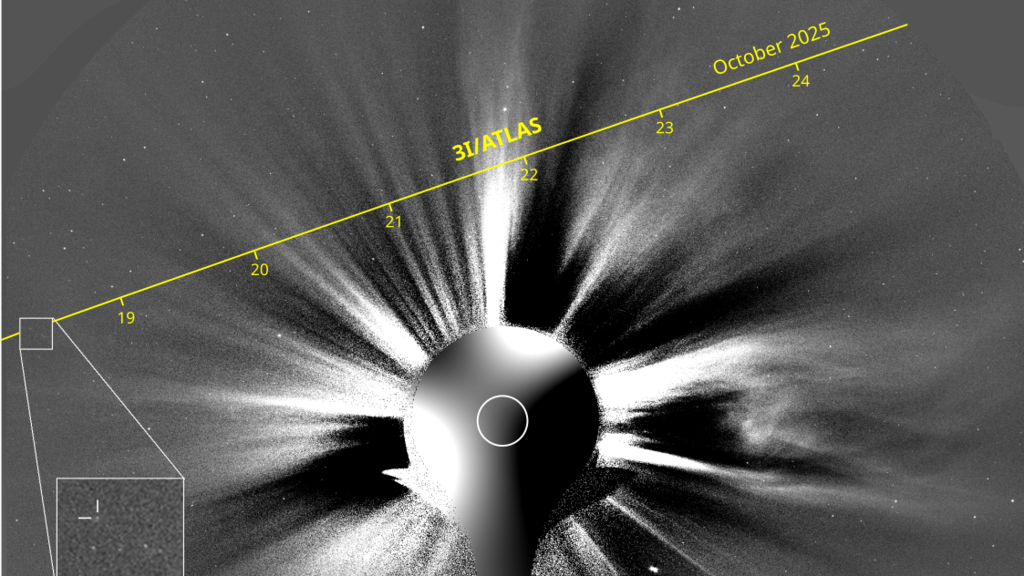By the date of its perihelion, 3I/ATLAS displayed the first evidence of a non-gravitational acceleration. The report (accessible here) was filed by Davide Farnoccia, a navigation engineer at NASA’s Jet Propulsion Laboratory in Pasadena who received his PhD in Mathematics from the Galileo Galilei School of Graduate studies at the University of Pisa, Italy.
The non-gravitational acceleration was measured at the perihelion distance of 1.36 times the Earth-Sun separation (defined as an astronomical unit or `au’), equivalent to 203 million kilometers. It had two components in the orbital plane of 3I/ATLAS:
· A radial acceleration away from the Sun of 135 kilometers (=9×10^{-7}au) per day squared.
· A transverse acceleration relative to the Sun’s direction of 60 kilometers (=4×10^{-7}au) per day squared.
If 3I/ATLAS is propelled by the rocket effect of ejected gas, then momentum conservation implies that the object would lose half its mass over a characteristic timescale equal to the ejection speed divided by the measured non-gravitational acceleration. For a thermal ejection speed of a few hundred meters per second, the evaporation half-life of 3I/ATLAS is 6 months. This implies that over the month it takes 3I/ATLAS to cross a spatial scale of order its perihelion separation from the Sun, 3I/ATLAS would lose about a tenth of its mass. Such a massive mass loss should be detectable in the form of a large plume of gas surrounding 3I/ATLAS during the upcoming months of November and December 2025.
ESA’s Juice spacecraft would be the first to detect this large mass loss in the first week of November. Later, on December 19, 2025, 3I/ATLAS will arrive closest to Earth at a separation of 269 million kilometers, when hundreds of ground-based telescopes as well as the Hubble and Webb space telescopes will have the best opportunity to observe it. Given that data, it should be clear if 3I/ATLAS lost a tenth of its mass through sublimation of volatile ices when it was heated by intense sunlight at perihelion.
Massive evaporation of 3I/ATLAS might explain its unusual brightening, as reported in a new paper (accessible here) based on observations of 3I/ATLAS from the STEREO, SOHO and GOES-19 instruments during the months of September and October 2025. The data shows a rapid rise in the brightness of 3I/ATLAS, scaling inversely with distance from the Sun to the power of -7.5 (±1).
Alternatively, the non-gravitational acceleration might be the technological signature of an internal engine. This might also explain the report on 3I/ATLAS getting bluer than the Sun (accessible here). For a natural comet this blue color is very surprising. Dust is expected to redden the scattered sunlight, and the surface of 3I/ATLAS is expected to be ~20 times colder than the 5,800 degrees Kelvin at the photosphere of the Sun, resulting in it having a redder color than the Sun. The blue appearance at perihelion is a ninth anomaly in the list of unexpected properties of 3I/ATLAS (compiled most recently here). It could potentially be explained by a hot engine or a source of artificial light.
The reported level of non-gravitational acceleration corresponds to a modest spatial deviation of order ten times the radius of the Earth over a period of a month, insufficient to bring 3I/ATLAS significantly closer to any Solar System planet from its original gravitational path.
This brings us to an anecdote from another event that took place today. As director of Harvard’s Institute for Theory and Computation, I lead every Thursday a luncheon attended by over a hundred astrophysicists. The event features four presentations on the latest advances in astrophysics. One of today’s presentations focused on the discrepancy between the current expansion rate of the Universe and the value expected for it based on the cosmic microwave background, the relic radiation from the hot dense matter in the first 400,000 years of cosmic history after the Big Bang. It appears very difficult to explain this anomaly in the data in terms of an elegant theoretical model. At the conclusion of the presentation which demonstrated beyond any statistical uncertainty that the discrepancy is real, I pointed out to all the young theorists in the audience: “It is a bad professional practice for theoretical astrophysicists to conclude that the data must be wrong just because they do not have a theoretical explanation for it.” Needless to say, the same lesson applies to the anomalies of 3I/ATLAS.
ABOUT THE AUTHOR
Avi Loeb is the head of the Galileo Project, founding director of Harvard University’s — Black Hole Initiative, director of the Institute for Theory and Computation at the Harvard-Smithsonian Center for Astrophysics, and the former chair of the astronomy department at Harvard University (2011–2020). He is a former member of the President’s Council of Advisors on Science and Technology and a former chair of the Board on Physics and Astronomy of the National Academies. He is the bestselling author of “Extraterrestrial: The First Sign of Intelligent Life Beyond Earth” and a co-author of the textbook “Life in the Cosmos”, both published in 2021. The paperback edition of his new book, titled “Interstellar”, was published in August 2024.
Source link


